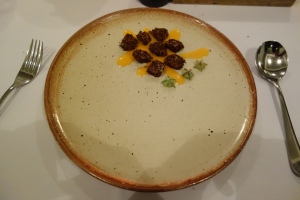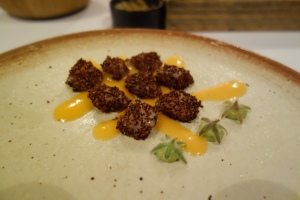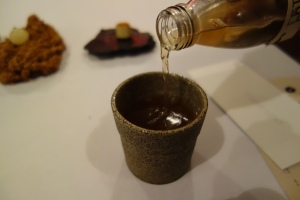- Address: Ca. Santa Isabel 376, Miraflores, Lima – Perú
- Telephone: [511]242-8515 / [511] 242-8575 | Email: reservas@centralrestaurante.com.pe
- Website: http://centralrestaurante.com.pe/
- Hours: Lunch: Monday-Friday, 1-330pm, Dinner: Monday-Saturday, 8-1130pm
- Price (after tax + tip, excl. drinks): $120
- Courses: (8 main/13 total) 2 amuse / 1 bread / 6 savory / 2 dessert / 2 mignardises
- Price/Main Course: $15
- Rating: 19.5/20
- Value: 5/5
- Dining Time: 140 minutes
- Time/Course (total): 11 minutes
- Chef: Virgilio Martinez (also proprietor of Lima in London, and another upcoming in London. ex. Lutèce (NYC), Can Fabes, Astrid y Gastón), Pía Leon (ex. El Celler de Can Roca)
- In Own Words: “My food is very visual, to me landscapes, feelings, romance, emotions are very important. I believe that my cuisine is very close to nature but in an artistic way.” [1]
- Style: Avant-garde Peruvian/Amazonian
- Notable: Rated by an influential local guidebook as best restaurant in Lima; platings are works of art.
Rating: 19.5/20
The Chef. Chef Virgilio Martinez’s fame precedes him. In the last year, he has opened a restaurant in London (called Lima), and he has another restaurant in Cuzco, gateway to Machu Picchu. An advocate of Peruvian cuisine worldwide, he is only 36 years old, and Central has been reviewed by Lima’s foremost dining guide (a little red book) as the best restaurant in Lima. Previous to opening Central, he worked at Lutèce (New York); Can Fabes (Sant Celoni, Spain), and served as executive chef at two restaurants of the Astrid y Gastón restaurant chain (prevalent in the Spanish world), in both Bogotá and Madrid.
You know what, I spent some time in Madrid and in Barcelona 10 years ago. After awhile, I went back to Peru and I saw more calm in the city. In the gastronomic sense, it was just okay, it was good. I had this epiphany when I went to Southeast Asia and I saw how people were very proud of street food. That really inspired me to go to the very unknown parts [of Peru]. So I got to know these parts, and I got to know all these ingredients. When I saw 200 ingredients that I’d never seen in my life, I was like, okay we have to do something with this because this is just amazing. And then we started to do the research on recipes with those ingredients. That was my personal motivation to go back to Peru and do my thing. – Virgilio Martinez
Two Visions of Peruvian Haute-Cuisine. Of the four high-end restaurants and menus I visited in three days in Lima, I could split them into two kinds – the first as Peruvian fusion (Astrid y Gaston’s [AyG] 20 years menu, Maido’s Nikkei menu); and the second highlighting Peruvian terroir (Central, Malabar, more casual: Amaz). I felt that the first type of Peruvian fusion haute-cuisine was not as enjoyable for me – it was almost as if I was being treated to a menu by committee, where disparate elements (Chinese shortrib and glutinous rice at Maido, Peking cuy and cannoli at AyG) were being put on my plate just to punch home the point that Peru was a cultural melting pot of Spanish, Italian, Incan, Chinese and Japanese immigrants. As if the presence of diversity on the menu was more important that the way tastes could unfold on the menu. In almost all of the cases, these “affirmative action” style dishes flopped. Fried rice with cod and oyster sauce does not a good dish make, AyG. The “affirmative action” trap is an all-too-common one that fusion restaurants fall into. The fusion restaurant gimmick: Ingredients from culture A are mixed with ingredients/preparations of culture B to produce a decent dish, but one in which the ingredients are replaceable, and there isn’t an essential reason to mix those two cultures. Very few fusion dishes follow an inner logic of the tastes themselves. A good rule of thumb seems to be: if fusion results in a dish that is merely interesting, don’t serve it. In the past year I could count on one hand the fusion dishes which were brilliant (sake-souffle at RyuGin, and Pejerrey Tiradito at Maido off the top of my head). Even at Maido (a restaurant I enjoyed very much), the only fusion dish which was essential was the tiradito; the other fusion dishes were well-executed but forgettable; and the chifa (Chinese-Peruvian) style dishes were consistently the weakest parts of the menu at both AyG and Maido.
I much preferred the Peruvian-terroir type restaurants. I learnt while researching Lima’s dining scene that there was a deviant strain of terroir-restaurants called “Amazonian cuisine”, attributed to Pedro Schiaffino of Malabar and Amaz. While I enjoyed both Malabar and Amaz, I felt that Peruvian-terroir took a big step up at Central. The flavors here were more precise and complex. It also has a larger canvas to play on – while a big part of Central’s ingredients comes from the Amazon, but it also encompasses all elevations and climes.
“Scientists have calculated that there are thirty-four types of climatic zones on the face of the earth. Peru has twenty of them. ‘In Inca Land one may pass from glaciers to tree ferns within a few hours,’ Bingham wrote, still astonished years after arriving.” – Turn Right at Machu Picchu, Mark Adams.
The Food. The menu I had was called Mater Uno. It has been expanded to about 18 courses now, but remained at about 13 courses when I visited in early January. The most memorable tastes were (1) the cut chirimoya fruit with cocoa – the chirimoya had the texture of pineapple with the taste of soursop; remarkable; and (2) the cushuro cyanobacteria with mashed frozen potato. The chefs at Central plate with painters’ brushes. In their hands, elegant paintings appear on our plates, feasts for the eyes. Occasionally the dining experience crosses over into didactism, where native Peruvian ingredients are placed on our plate just because the average diner has zero familiarity with them, and Central is trying to educate us on their provenance. But I always found the tastes precise, calibrated, with no flavour overwhelming the dish. Even though the food was unfamiliar, the tastes were balanced.
____________
MATER UNO
SEA: Seaweed Calamari (4.5/5)
Ceviche style.
COAST: Native Corn (4.5/5)
Intense corn taste.
AMAZON: Spicy Root (4.5/5)
Yacon (a sweet water chestnut-like root) smeared with a bit of charapita spicy pepper.
ANDES: Tuber Chamomile (5/5)
Camote (Andean sweet potato) that tasted like apple pie.
Special mention for the bread service goes to the “butter” (5/5), which is actually hardened butterscotch that is made solid. I ate a lot of it after taking this picture.
SNAPSHOT OF THE SEA (5/5)
Scallops, Kañihua, Tumbo, Borrage [10 mbmsi]
Raw scallops coated with kanihua (mountain grains); tropical fruit notes from the tumbo (banana-passionfruit sauce).
COASTAL INTERACTION (5/5)
Octopus, Purple Corn, Olive, Limo Chili [500 mamsi]
Perfectly roasted octopus, in a purple corn “corn-somme”.
WATERS OF THE LOWER ANDES (4.75/5)
River Shrimp, Sacha Inchi, Native Herbs, Chia [1200 mamsi]
The nutty and salty river shrimpes were paired with raw, verdant native herbs and chia. It was a complex composition, no taste dominating.
EXTREME ALTITUDE (5/5)
Frozen Potato, Cushuro, Mullaca Root, Paico [4500 mamsi]
This may have been the best dish of the night. Sour and springy cushuro (a type of cyanobacteria, which I also had the previous day at Maido), paired well with the mild taste of mash potato. It was a joy to crunch through the springy cushuro (which had a touch of turmeric taste) . Paico is a herb that starts off anise-tasting, and ends up minty.
RED JUNGLE (3.75/5)
Arapaima, Airampo, Huito, Hearts of Palm [800 mamsi]
The Amazonian arapaima riverfish is considered a delicacy for producing boneless steaks; here it had a savory ham-like texture. airampo, a cactus fruit stained the fish. Huito, charred on top, had a nutty almond like taste.
ALTIPLANO AND LAKE (3.25/5)
Lamb, Kiwicha, Tarwi, Chamomile [3800 mamsi]
Okay. Cheese taste from (chamomile?) cubes overpowering.
PURE AMAZON (4.25/5)
Bahuaja, Huampo Wood, Maca Root, Taperiba [500 mamsi]
Huampo root, boiled down (the green puree) had a menthol slightly limey flavor. Bahuaja nut, the central mass, was like a nutty semifreddo. Maca root crisps provides a taste of Froot Loops on the outside of the Bahuaja Nut; Taperiba formed the olive-colored gel.
MOUNTAIN RANGE AND FOREST (5/5)
Cacao, Coca, Chirimoya, Chaco Clay [2500 mamsi]
I loved this dish. I had chirimoya desserts at Borago, Gustu, Astrid y Gaston; but this took the cake. Chirimoya was served simply as the main dish; a fruit with the texture of pineapple and the taste of soursop. It was served simply with chocolate-coca soil. Simplicity.
SOLAR INFUSION
Cullen, Stevia, Macambo, Lemon Verbena [1200 mamsi]
____________
Notable Links:







































Hi, we have been trying to look for fine dining in South America and try to get an idea on the price and must say your blog is the most detailed blog we have came acrossed. Thank you so much! Just wondering with your price after tax, is it per person or two of you? It seems like you guys only order degustation menu right? Would much appreciate your response. Thank you!
Hi Winny, it is about 100-130 USD per person for the full tasting without wine. There is also an extensive a la carte menu available.
Cool! That’s awesome. Thanks for your reply! Really enjoy your blog btw, impressed you can be so detailed 🙂 Look forward to more of your food sharing!
Thanks for the kind words 🙂